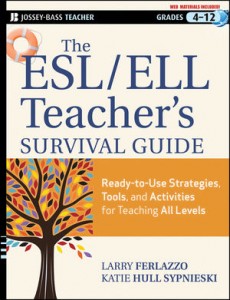Teaching ESL/ELL Students
 A MiddleWeb Interview
A MiddleWeb Interview
The number of English language learners in U.S. schools is projected to grow as much as 25 percent by 2025 and many teachers already find themselves challenged to help students whose first language is not English be successful. They are an important audience for The ESL/ELL Teacher’s Survival Guide, a new book from Jossey-Bass that promises “Ready-to-Use Strategies, Tools, and Activities for Teaching English Language Learners of All Levels.”
Back in the summer, we interviewed Survival Guide co-author Larry Ferlazzo about some other topics. So this time we’ve asked his fellow author (and teaching colleague) Katie Hull Sypnieski to answer five questions about their new book.
Katie has taught English Language Learners across the grades for the past 15 years and currently teaches English at Luther Burbank High in Sacramento CA. She’s also a teaching consultant with the Area 3 Writing Project at UC Davis and a lead trainer for the WRITE Institute.
 1. Thanks, Katie, for taking some time at the start of the school year to answer our questions. The title of your book might suggest that it’s aimed at “specialist teachers” who work exclusively with ESL/ELL students. Is that the case?
1. Thanks, Katie, for taking some time at the start of the school year to answer our questions. The title of your book might suggest that it’s aimed at “specialist teachers” who work exclusively with ESL/ELL students. Is that the case?
While this book is a great resource for teachers working exclusively with ELLs, it is also a valuable tool for mainstream teachers. Both Larry and I teach mainstream English courses as well as ESL, and we use the strategies presented in this book with all our students. There are separate chapters on how mainstream teachers can more effectively teach ELLs in their math, English, science and social studies classes. And, as we’ve found ourselves, many of the teaching techniques for ELL’s can be effective with all students.
2. Can you tell us something about ELL student trends around the nation?
It’s hard to find a school or district in this country that doesn’t have an English Learner population, and in states like California, Texas, Florida, and New York it is sometimes hard to find a classroom without any English Language Learners. In fact, the US Department of Education estimates that approximately 4.5 million English Learners are enrolled in public schools across the country, roughly 10% of all students enrolled in K-12 schools in the United States. The number of English Learners has increased by over 50% in the last decade, with some states, like South Carolina and Indiana, experiencing extremely rapid growth of English Learner populations (400-800% increases). The ELL population continues to grow with some demographers predicting that in 20 years or less the ratio of ELL students to English-Only students could be one in four.
3. A new school year is beginning, and we think about new teachers and teachers who may have English language learners in their classrooms for the first time. Your book is a “survival guide.” What are the basic do’s and don’ts of working with these students?
Do model for students what they are expected to do or produce, and don’t just tell students what to do and expect them to do it.
Do speak clearly and slowly and provide students with enough time to formulate their responses in speaking or writing, and don’t speak too fast or repeat something back to students word for word in a louder voice!
 Do use visuals, sketches, gestures, intonation, and other nonverbal cues to make both language and content more accessible to students, and don’t stand in front of the class and lecture, or rely on a textbook as your only “visual aid.”
Do use visuals, sketches, gestures, intonation, and other nonverbal cues to make both language and content more accessible to students, and don’t stand in front of the class and lecture, or rely on a textbook as your only “visual aid.”
Do give verbal and written instructions — this practice can help all learners, especially ELLs, and don’t act surprised if students are lost when you haven’t clearly written and explained step-by-step directions.
Do regularly check that students are understanding the lesson by having all students respond with “thumbs up or down” or writing their responses on a sticky note or individual whiteboard, and don’t simply ask, “Are there any questions?”
Do encourage students to continue building their literacy skills in their first language (L1) as research shows learning to read in their L1 promotes reading achievement in L2 as “transfer” occurs. And don’t “ban” students from using their native language in the classroom.
4. Are there special considerations for teaching English language learners in the middle grades (4-8)?
It is important for teachers, including those who teach specific content courses, to remember that a lack of proficiency in English does not mean that a student’s intelligence is any less. These students bring a wealth of knowledge and experience to the classroom. When teachers allow students to draw on this knowledge and to make connections to new learning, then more language development occurs.
For example, beginning-level students may not be able to express their ideas in writing, but they can be asked to draw pictures to communicate their thinking. It is also important for teachers to keep this in mind when assessing ELLs and to always assess knowledge and language separately. For example, asking beginning-level students to demonstrate their knowledge of a plant’s life cycle by writing an essay is more a test of their English skills than their actual content knowledge.
5. What about ELL beyond the E/LA classroom? What do teachers without a primary responsibility for literacy instruction need to know? And how does the Common Core figure in?
The Common Core State Standards make it very clear that literacy instruction be a “shared responsibility within the school.” Effective teaching of ELLs in core subjects like math, science, and social studies involves teaching students content and the academic language and literacy strategies needed to access that content.
Larry and I believe the Common Core can have a positive impact on ELL students if teachers in all content areas are working together to build students’ literacy skills. Of course, an area which greatly impacts ELLs is how they will be assessed. We hope that the next generation of standardized tests will respect language acquisition research and that they will be more connected to performance-based assessment, will offer translations in multiple languages, and will adhere to the concept of “universal design” by simplifying language demands that aren’t relevant to content being measured.
You can learn more about The ESL/ELL Teacher’s Survival Guide at Larry Ferlazzo’s website page, which includes links to a lengthy list of excerpts available around the Web. There you can also read the 3-part archive of a live Twitter chat about the book and ESL/ELL education. Watch for a review of the book here at MiddleWeb soon.


































3 Responses
[…] addthis_share = [];}Middleweb, one of my favorite blogs and email newsletters, has just published an interview with my friend, colleague, and co-author of The ESL/ELL Teacher’s Survival Guide, Katie Hull […]
[…] Language Learners. In one blog he included an interview with the co-author of “ESL/ELL Teacher’s Survival Guide” which contained a lot of useful information on teaching ELL students. The main thing that […]
[…] Katie Hull Sypnieski, co-author of The ESL/ELL Teacher's Survivor Guide, shares do's and don'ts for all teachers with ELL students. […]